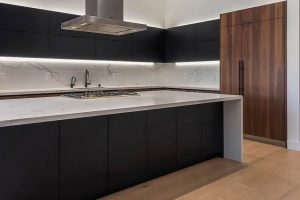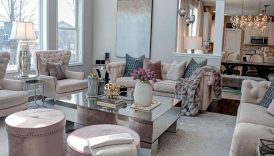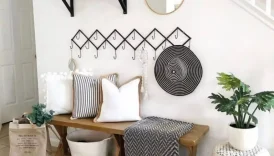Top 10 Trending Kitchen Designs for 2021

In today’s ever-evolving world of home design, the kitchen stands as more than just a place for meal preparation; it’s a central hub for family gatherings, social interactions, and creative culinary experiences. The diversity of kitchen design styles gives homeowners an opportunity to express their personality and preferences while ensuring functionality. From sleek minimalist spaces to charming farmhouse nooks, there’s a perfect kitchen design waiting to inspire.
- Top 10 Trending Kitchen Designs for 2021
- Why Kitchen Design Matters
- Minimalist Kitchen Design
- Neutral Color Schemes
- Sleek Lines and Minimalist Decor
- Farmhouse Kitchen Design
- Reclaimed Wood Elements
- Vintage Accents
- Smart Kitchen Design
- High-Tech Appliances
- Smart Storage Solutions
- Open Shelving Kitchen Design
- Floating Shelves
- Displaying Kitchenware as Decor
- Sustainable Kitchen Design
- Eco-Friendly Materials
- Energy-Efficient Appliances
- Scandinavian Kitchen Design
- Light Wood Finishes
- Simple Yet Functional Layout
- Industrial Kitchen Design
- Exposed Brick Walls
- Metal Accents and Pipes
- Transitional Kitchen Design
- Blend of Modern and Traditional Elements
- Mix of Textures and Finishes
- Moody Kitchen Design
- Dark Color Palettes
- Dramatic Lighting Options
Why Kitchen Design Matters
Choosing the right kitchen design can significantly enhance the overall ambiance of your home. A well-thought-out kitchen not only looks good but also contributes to smooth workflow and efficiency during cooking and entertaining. Consider these impactful elements:
- Functionality: Easy access to tools and ingredients
- Aesthetics: A visually appealing space can elevate your mood
- Value: A stylish kitchen can increase property value
Reflect on your culinary habits and lifestyle preferences as you explore different kitchen design trends, ensuring your dream kitchen is both beautiful and functional. With various styles to examine, let’s dive into some of the most popular kitchen designs today.
Minimalist Kitchen Design
Transitioning from the idea of a central kitchen, let’s explore the minimalist kitchen design, a style that embraces simplicity while maximizing functionality. With a focus on clean lines and uncluttered spaces, minimalist kitchens have become a popular choice for modern homeowners looking to create an inviting yet efficient cooking area.
Neutral Color Schemes
Neutral color palettes lie at the heart of minimalist kitchen design. These subtle shades promote calmness and harmony within the space. Think soft whites, grays, and beige, which can create an expansive feel. This also allows other design elements, such as textures and materials, to shine. Here’s how to incorporate neutral colors:
- Cabinetry: Opt for matte finishes in shades like soft taupe or crisp white.
- Countertops: Choose natural stone or quartz with gentle veining.
- Backsplashes: Subtle tiles in neutral tones can blend seamlessly with walls.
By using neutral colors, you create a serene environment, making cooking and entertaining a more pleasurable experience.
Sleek Lines and Minimalist Decor
Alongside color choice, sleek lines are a defining feature of minimalist kitchens. The focus is on simplicity, appearing as if everything has its designated place and nothing is superfluous. Consider these tips for achieving a streamlined look:
- Flat-front Cabinets: Choose cabinetry without handles for a seamless appearance.
- Integrated Appliances: Opt for built-in appliances that blend with the cabinetry.
- Minimal Accessories: Use only essential kitchenware on the counter to maintain a clean look.
When I redesigned my own kitchen, I found that eliminating unnecessary decor not only opened up the space visually but also made it easier to maintain. Embracing minimalist decor creates a fresh and airy ambiance that enhances the joy of cooking.
Farmhouse Kitchen Design
Shifting gears from minimalist elegance, let’s dive into the warmth and charm of farmhouse kitchen design. This style captures a sense of nostalgia and comfort, making it an inviting space for family gatherings and hearty meals. Farmhouse kitchens blend rustic elements with modern functionality, creating a truly unique atmosphere.
Reclaimed Wood Elements
One of the hallmarks of farmhouse design is the use of reclaimed wood. This not only brings a rich history into the space, but it also adds character and texture. Here are some ways to incorporate reclaimed wood:
- Countertops: Consider solid wood countertops sourced from old barns or fences.
- Open Shelving: Shelves made from reclaimed wood can showcase your favorite kitchenware.
- Flooring: Wide-plank hardwood flooring with natural finishes enhances the rustic appeal.
When I visited a friend’s farmhouse, the reclaimed wood accents struck me – each piece had a story, sparking conversations as we cooked together.
Vintage Accents
Vintage accents further elevate the farmhouse aesthetic, bringing a sense of history and craftsmanship. Here’s how to infuse these charming elements into your kitchen:
- Farmhouse Sink: A classic porcelain sink adds a statement to any kitchen.
- Antique Lighting: Incorporate pendant lights or chandeliers with an aged finish.
- Decorative Items: Display a mix of vintage jars, cookbooks, and rustic utensils.
These touches create a cozy and inviting atmosphere that makes anyone feel right at home. By blending reclaimed wood and vintage accents, your farmhouse kitchen will become a cherished space for family memories and shared meals.
Smart Kitchen Design
Now, let’s transition into the world of smart kitchen design, where technology meets functionality to create innovative cooking spaces. These kitchens not only simplify cooking tasks but also elevate the overall kitchen experience with cutting-edge features. Embracing smart kitchen design can transform your culinary endeavors into a seamless and enjoyable process.
High-Tech Appliances
At the heart of any smart kitchen are high-tech appliances that streamline tasks and enhance cooking efficiency. These gadgets are designed to make life easier. Here are a few standout examples:
- Smart Refrigerators: These come equipped with touch screens and cameras, allowing you to check contents via your smartphone while grocery shopping.
- Wi-Fi-Enabled Ovens: With these, you can preheat or adjust cooking times remotely through an app, ensuring dinner is ready when you are.
- Voice-Activated Assistants: Devices like smart speakers can help with recipes, timers, and even play your favorite cooking playlists.
I was amazed during a recent dinner party when my friend used her smart oven to roast a chicken, all while helping her kids with homework. It made multitasking effortless!
Smart Storage Solutions
In addition to appliances, smart storage solutions are a game-changer in maximizing kitchen space. These features organize and simplify accessibility. Consider these options:
- Pull-Out Cabinets: Ideal for narrow spaces, allowing easy access to pots and pans.
- Corner Drawers: No more wasted space; these drawers utilize every nook efficiently.
- Overhead Racks: Save counter space by hanging pots and pans, keeping them within reach yet out of the way.
With these smart solutions in place, kitchens can feel more open and organized. I’ve experienced firsthand the difference smart storage can make – it keeps everything tidy and makes cooking enjoyable, rather than chaotic. Embracing smart kitchen design truly revolutionizes how we cook and interact in everyday life.
Open Shelving Kitchen Design
Following our exploration of smart kitchens, let’s delve into the charming world of open shelving kitchen design. This approach not only maximizes space but also brings a sense of airiness and style to the kitchen. Open shelving has gained popularity for its practicality and aesthetics, creating an inviting backdrop for cooking and entertaining.
Floating Shelves
Floating shelves are a staple in open shelving design, providing a chic way to display kitchen essentials. These shelves can create a light and spacious feel, making your kitchen appear larger. Here are a few tips for incorporating floating shelves effectively:
- Placement: Install shelves at varying heights to draw the eye upward and add dimension.
- Materials: Choose natural wood or sleek glass for a contrast with your kitchen colors.
- Lighting: Consider adding LED strips under the shelves to highlight your displays and create ambiance.
I fondly remember my aunt’s kitchen, where floating shelves held not just dishes but also her favorite cookbooks, making it a personal gallery.
Displaying Kitchenware as Decor
Transforming your kitchenware into decor is another exciting aspect of open shelving. Use your favorite items creatively to enhance your kitchen’s visual appeal. Here are some ideas to consider:
- Color Coordination: Group items by color for a striking visual impact.
- Layering: Mix and match larger and smaller pieces to create depth.
- Seasonal Displays: Refresh your shelves with seasonal items, such as holiday-themed dishware or vibrant fruits.
By showcasing kitchenware as decor, you blend functionality with personal style, making the kitchen not only a place for cooking but also an extension of your personality. Open shelving kitchen design allows your space to flourish with your unique taste, making every meal preparation an enjoyable experience.
Sustainable Kitchen Design
After exploring open shelving, let’s shift our focus to sustainable kitchen design, an essential consideration for environmentally-conscious homeowners. As awareness grows around climate change and resource conservation, integrating sustainable practices into kitchen design has never been more vital. Not only does it benefit the planet, but it can also create a healthier home environment.
Eco-Friendly Materials
Choosing eco-friendly materials is fundamental in sustainable kitchen design. These materials reduce your carbon footprint while enhancing the aesthetic of your space. Consider these options:
- Bamboo Countertops: Bamboo is a renewable resource that grows quickly, providing a stylish and sustainable surface.
- Recycled Glass Tiles: Using tiles made from recycled materials adds visual interest and reduces waste.
- Low-VOC Paint: This reduces harmful emissions, contributing to better indoor air quality.
When I renovated my kitchen, I opted for bamboo cabinetry. I was surprised at how gorgeous and durable it was while feeling good about the environmental impact.
Energy-Efficient Appliances
Investing in energy-efficient appliances is another key element of sustainable kitchen design. These appliances reduce energy consumption and save you money over time. Here’s what to look for:
- Energy Star Ratings: Appliances with this label meet strict efficiency guidelines, providing significant energy savings.
- Smart Thermostats: These can optimize energy usage based on your cooking patterns.
- Induction Cooktops: They heat quickly while using less energy than traditional gas or electric ranges.
Transitioning to energy-efficient appliances transformed my daily cooking experience. Not only did I notice a drop in my utility bills, but the performance of my sleek new appliances was truly impressive. By focusing on eco-friendly materials and energy-efficient options, your kitchen can be a beautiful, functional, and sustainable space.
Scandinavian Kitchen Design
Continuing our exploration of sustainable elements, let’s now focus on Scandinavian kitchen design, which embodies simplicity, functionality, and warmth. Characterized by minimalist aesthetics and a love for nature, Scandinavian kitchens create inviting, cozy spaces that are as beautiful as they are practical.
Light Wood Finishes
One of the defining features of Scandinavian kitchens is the use of light wood finishes. This choice brings warmth and an organic feel to the space, aligning perfectly with the region’s natural beauty. Here are some effective ways to incorporate light wood finishes:
- Cabinetry: Choose light-colored woods like birch, pine, or ash for a fresh and airy look.
- Open Shelving: Floating wooden shelves can highlight your favorite kitchen items while keeping the design open and uncluttered.
- Flooring: Light wood flooring creates an inviting base that elevates the entire kitchen aesthetic.
I recall visiting a friend’s cabin in northern Scandinavia, where the light wood interiors instilled a sense of calmness and connection to nature.
Simple Yet Functional Layout
In addition to wood finishes, Scandinavian design emphasizes a simple yet functional layout. This approach maximizes usability without sacrificing style. Here are some tips to achieve this design philosophy:
- Efficient Work Triangle: Arrange the stove, sink, and refrigerator within easy reach to facilitate cooking.
- Decluttered Counters: Incorporate minimalist decor to keep surfaces clear, allowing for easy meal prep.
- Multipurpose Furniture: Consider islands or tables that can serve dual roles, like additional prep space or dining areas.
When I redesigned my space, I found that a straightforward layout allowed for effortless movement and organization. By embracing these principles, a Scandinavian kitchen becomes a haven of functionality and style, perfect for everyday living.
Industrial Kitchen Design
Having explored the simplicity of Scandinavian designs, let’s transition into the edgy and contemporary vibe of industrial kitchen design. This style celebrates raw materials and often evokes the feel of a chic urban loft. With its unique blend of practicality and aesthetic appeal, industrial kitchens are perfect for those looking to make a bold statement in their home.
Exposed Brick Walls
One of the hallmark features of industrial kitchens is the use of exposed brick walls. This architectural element adds warmth and texture while maintaining a rugged charm. Here are some ideas for incorporating brick into your kitchen:
- Accent Wall: Choose one wall to expose the brick, creating a stunning focal point.
- Painted Brick: If the original color doesn’t suit your style, consider a clean white wash to brighten the space.
- Combination with Modern Elements: Pair brick walls with sleek modern cabinetry for a captivating contrast.
I once had dinner in an industrial-themed restaurant, and the rustic brick walls instantly transported me to a cozy yet sophisticated atmosphere.
Metal Accents and Pipes
Equally important are the metal accents and visible pipes that define industrial kitchens. These elements convey authenticity and emphasize the overall design theme. Here’s how to integrate them:
- Open Pipes: Leave pipes exposed for a true industrial feel; consider painting them in black or metallic colors.
- Metal Fixtures: Use stainless steel for countertops, sinks, and appliances to enhance the industrial vibe.
- Light Fixtures: Opt for pendant lighting in matte black or polished metal to add an industrial flair while illuminating your space.
In my own kitchen redesign, incorporating metal shelving helped create a utilitarian look that felt both functional and stylish. By embracing exposed brick and metal accents, your kitchen can exude a trendy and rugged character that is sure to impress.
Transitional Kitchen Design
As we move from the boldness of industrial kitchens, let’s delve into transitional kitchen design, a perfect harmony of modern and traditional elements. This style appeals to homeowners who aren’t quite ready to fully commit to either aesthetic, choosing instead to blend the best of both worlds for a timeless yet contemporary look.
Blend of Modern and Traditional Elements
One of the most striking features of transitional kitchens is the seamless blend of modern and traditional styles. Here’s how to achieve this balance:
- Cabinet Styles: Use classic shaker-style cabinets paired with sleek hardware for a nod to tradition while keeping it fresh.
- Countertop Choices: Combine materials such as granite or quartz with butcher block accents for a warm yet modern feel.
- Appliance Selection: Select modern appliances that feature clean lines but in a retro-inspired color palette for a playful contrast.
I’ll never forget a family gathering at my cousin’s transitional kitchen; the mix of styles was not only stunning but also made everyone feel at home.
Mix of Textures and Finishes
In transitional design, varying textures and finishes can elevate the overall aesthetic. Here are some effective ways to incorporate this concept:
- Layering Textures: Combine smooth cabinetry with rough-hewn tables or open shelving made from reclaimed wood.
- Contrast Finishes: Don’t be afraid to mix matte and glossy finishes, such as satin-finished cabinets alongside polished backsplashes.
- Decorative Accents: Incorporate textiles like woven placemats or patterned curtains to soften the space and add warmth.
In my experience, blending textures made my kitchen feel inviting yet sophisticated. By embracing both modern and traditional elements, along with a mix of textures, your transitional kitchen will truly stand out as a warm, functional hub for family and friends.
Moody Kitchen Design
As we leave the warmth of transitional kitchens, let’s explore the captivating allure of moody kitchen design. This style is all about embracing darker tones and dramatic features to create a bold and intimate atmosphere. If you’re looking to make a statement in your kitchen, a moody design might be just what you need.
Dark Color Palettes
The foundation of moody kitchen design lies in rich, dark color palettes that evoke sophistication and elegance. Here are some tips for choosing the right colors:
- Deep Greens and Blues: These colors can create a serene yet powerful vibe, perfect for accent walls or cabinetry.
- Charcoal Gray: It adds a striking contrast without feeling too harsh, especially when paired with lighter elements.
- Black Accents: Consider black fixtures, appliances, or backsplashes to enhance the overall dramatic effect.
At a dinner party at a friend’s moody kitchen, I was mesmerized by how the deep colors created a cozy, welcoming ambiance.
Dramatic Lighting Options
To amplify the moodiness, focus on dramatic lighting that complements the darker tones. Effective lighting can transform the space and create an inviting atmosphere. Here are a few ideas:
- Statement Fixtures: Oversized pendant lights or a striking chandelier can serve as focal points, enhancing the overall aesthetic.
- Under-Cabinet Lighting: Soft lights underneath cabinets can illuminate workspaces while adding a warm glow.
- Layered Lighting: Combine ambient, task, and accent lighting to create depth and interest in the space.
I remember my amazement as my friend flipped on her new pendant lights, instantly brightening her entire kitchen while accentuating the moody colors beautifully. By integrating dark color palettes and dramatic lighting, your kitchen can transform into an elegant and inviting space, perfect for hosting friends and family.





